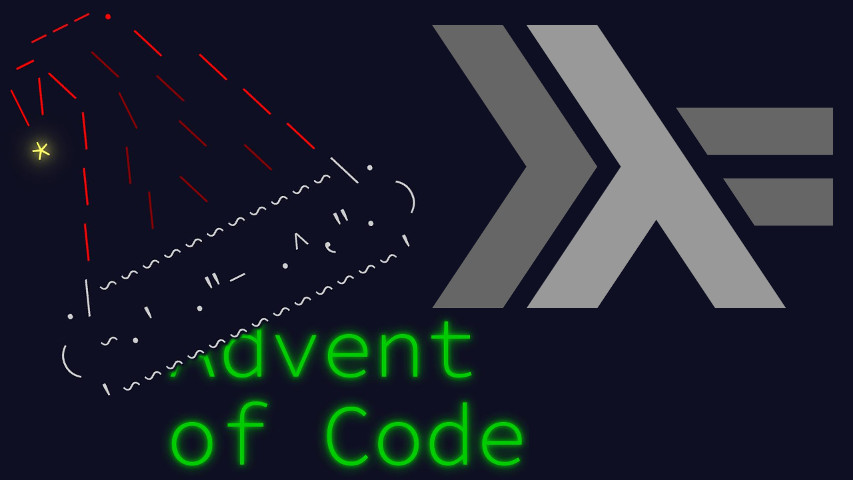Day 6 of Advent of Code, “Lanternfish”, caught me by surprise. This post is literate Haskell as usual, so here’s an imports block to serve as a prologue.
import Control.Arrow ((&&&))
import Control.Lens
import Data.List.Split (wordsBy)
import Data.Semigroup (stimesMonoid)
import Linear.V (V(V),toVector)
import Linear.Vector (zero,basis)
import Linear.Matrix ((!*!),(!*),identity,transpose)
import Data.Vector.Lens (toVectorOf)The problem describes the individual detail of a lanternfish’s population exponential growth and requests the specific population count at some point in the future. Part 1 requests for 80 iterations, so part 2 will most likely ask for some duration in the order of magnitude of a billion days, so as to be intractable with a simple linear approach.
Anyway, let’s start simple, we’ll expand from there.
Fish with the same internal timer value are indistinguishable, so let’s group them into an array, indexed by timer value.
type Population = V 9 Int
parse :: String -> Population
parse = aggregate . unCsv where
unCsv = map read . wordsBy (== ',')
aggregate = foldl (\v i -> v & ix i +~ 1) zeroHow many fish of each timer index are there after a day? For most timer values, it’s simply the same number as there were with a timer one higher. The two exceptions are:
- timer value 6: in addition to the fish that were at timer value 7, this group will also receive the fish who just reproduced, i.e. the fish that were at timer value 0.
- timer value 8: there’s no timer value 9 to collect from, but there’s the newborn fish to account for. Those are as numerous as there were fish at timer value 0.
This gives the following step function:
step :: Population -> Population
step v = other' & _7 +~ breeders where
Just (breeders,other) = uncons (toVector v)
other' = V (snoc other breeders)And we get the answer to part 1 with a simple pipeline:
show . sum . (!! 80) . iterate step . parseWe then get to part 2 who makes turns the problem around by requesting the value for as many as… 256 days.
Oh.
That’s going to take, like, more than three times longer! The horror.
main :: IO ()
main = interact $ show . ((!! 80) &&& (!! 256)) . map sum . iterate (step) . parseSo be it.
Upping the Ante
I can’t settle for this. How would we find the answer for a (much) larger number of days in a reasonable time?
The result would be a crazy big number, unwieldy for a simple web form. In a competitive coding environment we’d typically only be asked for the residue modulo \(10^9+7\) or similar large prime.
The step function as presented above runs in constant
time and space, even when additionally computing residues. How can we do
better?
The most common approach is to exploit linearity. Our step function is a (linear) endomorphism, so it can be written in matrix notation:
\[ M = \left(\begin{array}{ccccccccc} 0 & 1 & 0 & 0 & 0 & 0 & 0 & 0 & 0 \\ 0 & 0 & 1 & 0 & 0 & 0 & 0 & 0 & 0 \\ 0 & 0 & 0 & 1 & 0 & 0 & 0 & 0 & 0 \\ 0 & 0 & 0 & 0 & 1 & 0 & 0 & 0 & 0 \\ 0 & 0 & 0 & 0 & 0 & 1 & 0 & 0 & 0 \\ 0 & 0 & 0 & 0 & 0 & 0 & 1 & 0 & 0 \\ 1 & 0 & 0 & 0 & 0 & 0 & 0 & 1 & 0 \\ 0 & 0 & 0 & 0 & 0 & 0 & 0 & 0 & 1 \\ 1 & 0 & 0 & 0 & 0 & 0 & 0 & 0 & 0 \end{array}\right) \]
newtype Matrix = M { unM :: V 9 (V 9 Int) }
m :: Matrix
m = M (transpose (step <$> V (toVectorOf each basis)))Our simulation primitive can then be represented as an endomorphism whose transformation matrix has the form \(M^i\), and can be computed in logarithmic time1 using exponentiation by squaring.
instance Semigroup Matrix where M a <> M b = M (a !*! b)
instance Monoid Matrix where mempty = M identity
simulate :: Population -> Int -> Population
simulate start i = unM (stimesMonoid i m) !* startLet’s verify it yields reasonable output.
λ> take 20 $ sum <$> iterate step (parse "3,4,3,1,2")
[5,5,6,7,9,10,10,10,10,11,12,15,17,19,20,20,21,22,26,29]
λ> take 20 $ sum <$> map (simulate (parse "3,4,3,1,2")) [0..]
[5,5,6,7,9,10,10,10,10,11,12,15,17,19,20,20,21,22,26,29]
λ> find (uncurry (/=)) $
zip (iterate step (parse "3,4,3,1,2"))
(map (simulate (parse "3,4,3,1,2")) [0..])
<<time passes>>
Interrupted.Looks good to me.
A final warning. I’m using stimesMonoid to skip
re-implementing exponentiation by squaring yet again. You may recall Endo
is an instance of Monoid too. Why am I not simply using
stimesMonoid i (Endo step) to skip the matrix stuff
altogether? The short answer is that though it would indeed yield the
correct results, it wouldn’t do so in the targetted timeframe. Can you
spot why?
This concludes today’s solution. See you tomorrow!
For constant-sized contents. Which is the case for mod-\(10^9+7\) arithmetic.↩︎



